Sustainable Categories: Our Services
Another old tip turned into parkland in Kingston
HVO100 at Cleanaway is lowering emissions and keeping engines clean
"Although the filters from the HVO100 truck have had less mileage than the ones from the truck running on mineral diesel, they are still surprisingly clean. A lot cleaner than I would’ve predicted." National Fleet Repair and Maintenance Support Coordinator Danny Martin .
"Although the filters from the HVO100 truck have had less mileage than the ones from the truck running on mineral diesel, they are still surprisingly clean. A lot cleaner than I would’ve predicted." National Fleet Repair and Maintenance Support Coordinator Danny Martin .
Cleanaway is pioneering the use of HVO100 renewable diesel in two of its waste management vehicles out of the Perry Road depot in Dandenong South, Victoria. The demonstration started in February this year and we released a comprehensive mid-way update in June, showing that HVO100 provides equivalent fuel consumption, uptime and performance compared to fossil diesel. As we approach the last stage in the demonstration, this update speaks to emissions reduction and effect on engine maintenance.
Emissions reduction
HVO100 is a 100% renewable diesel made from renewable sources such as used cooking oil. It is near chemically identical to mineral diesel which means it’s a “drop-in” replacement requiring no new infrastructure, fleet, or additional capital. As it is made from renewable resources, all carbon in the fuel has been captured from the atmosphere that is released again upon combustion, resulting in net zero carbon emissions.
In the first 6 months of the demonstration, we have used 32kL of HVO100 and saved 87 tonnes CO2-e compared to burning fossil fuel-based diesel; emissions savings are calculated using the 2023 National Greenhouse Account Factors provided by the Australian Department of Climate Change, Energy, the Environment and Water.
Effect on fuel filters
The fleet maintenance team at Perry Road have been monitoring the effect of HVO100 on engine performance thoroughly and taken a close look at the fuel filters upon replacement at regular maintenance intervals. Pictures of those filters after they were removed are shown below, both for the truck running on HVO100 and another identical truck fuelled with mineral diesel. Cleanaway’s National Fleet Repair and Maintenance Support Coordinator Danny Martin commented, “Although the filters from the HVO100 truck have had less mileage than the ones from the truck running on mineral diesel, they are still surprisingly clean. A lot cleaner than I would’ve predicted.”
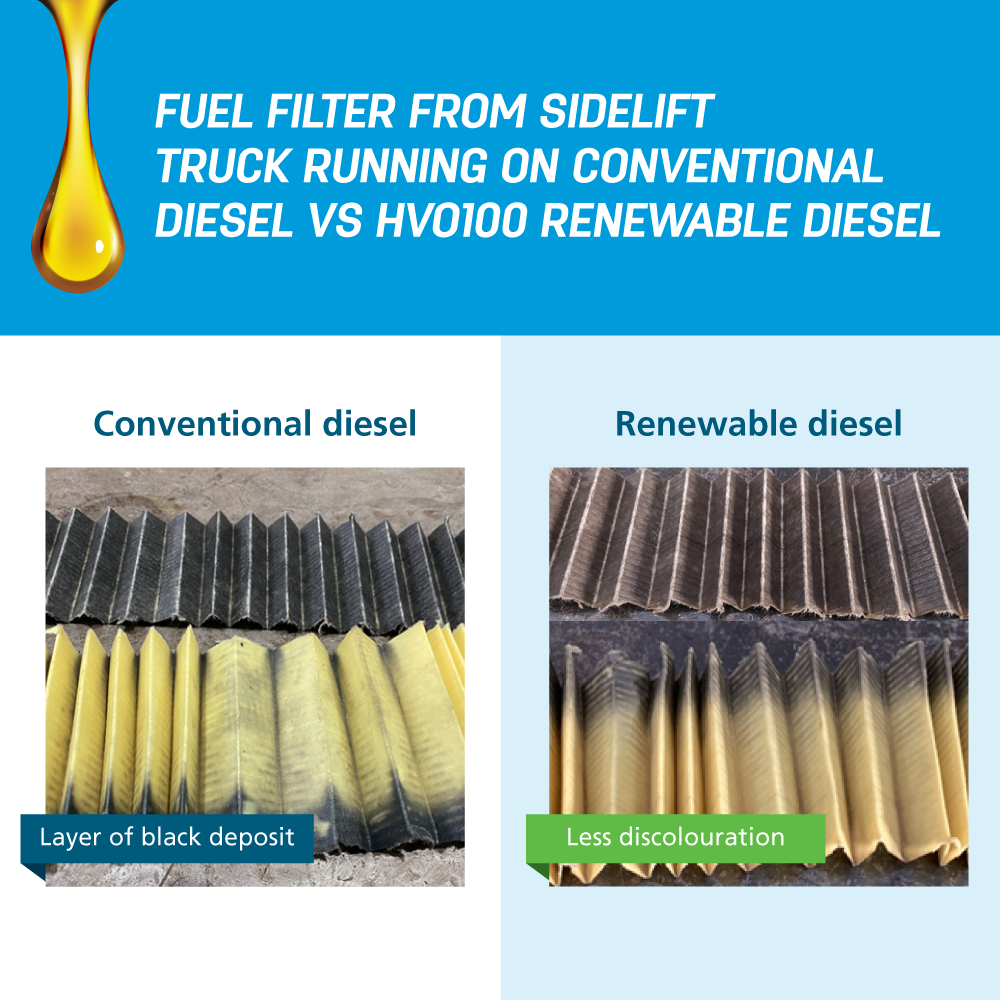
The road ahead
Cleanaway’s demonstration of HVO100 is coming to an end in September with the last delivery of the fuel going into the on-site tank in the coming weeks. The demonstration has confirmed the technical and operational compatibility of HVO100 with our current fleet. We’re excited to offer this service in a variety of locations for customers looking for low emission waste management services. In parallel, Cleanaway continues to work with governments and industry to create a policy framework in Australia that supports the uptake of low carbon liquid fuels to meet the nation’s climate reduction targets.
Cleanaway awarded Canstar Blue’s ‘Most Satisfied Customers’ award
“I've always used these guys with no problems”. – Female, QLD
“I've always used these guys with no problems”. – Female, QLD
Cleanaway is proud to be awarded Canstar Blue’s ‘Most Satisfied Customers’ award in the Small Business Waste Management category. This award reflects the hard work of our frontline teams who provide a high level of service to our customers.
We know that for small businesses, a great waste management service is often “out of sight, out of mind”. That’s why we’re committed to providing reliable, value for money, sustainable services. Importantly, we pride ourselves on giving our customers options so we’re pleased to be recognised for our service frequency and availability, and equipment options.

Environmental protection is one of our foundations at Cleanaway and we know it’s important to our customers too. The survey has provided some valuable insights on the number of small businesses that value working with a provider that they can trust – not just with protecting the environment but to do the right thing with the material we collect. You can read more about how we manage your recycling here: So what really happens to our recycling? | Cleanaway.
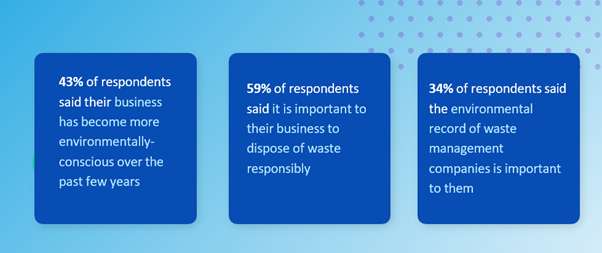
Some of the best insights from the survey came directly from our customers, here’s what they had to say:
“Essential for waste management.” – Male, Victoria
“Easy to book options, can easily ask for more servicing, good value” – Female, NSW
“I’ve always used these guys with no problems”. – Female, QLD
“Recycling for paper” – Male, WA
To see the award and read more about Canstar Blue’s process for recognising consumer choice visit: https://www.canstarblue.com.au/stores-services/waste-management-services/
HVO100 performs for Cleanaway fleet decarbonisation
“We're committed to leading our industry with innovative and fit for purpose solutions that align with our customers‘ goals while working towards federal emissions targets.”
“We're committed to leading our industry with innovative and fit for purpose solutions that align with our customers‘ goals while working towards federal emissions targets.”
Key outcomes:
- HVO100 provides equivalent or better fuel consumption, uptime and performance compared to mineral diesel oil in two Cleanaway heavy vehicles and has avoided the emission of 37 t CO2 so far.
- Customers, employees, and industry recognise the benefits of this renewable fuel and would like to see a roll out of low carbon liquid fuels at larger scale.
- Policies to support the uptake of low carbon liquid fuels have been announced by the federal government, which will be essential to level the playing field and drive increased market penetration.
For Cleanaway the pathway to decarbonisation won’t happen overnight but results from our on-road demonstration of HVO100 renewable diesel show the answer might be right under our nose.
In February 2024 we began operating two heavy collection vehicles from our Perry Road depot on HVO100 – a fossil fuel alternative made from renewable resources such as used cooking oil. The objective of the demonstration is to collect data about whether the vehicles which pull a 7-9 tonne payload on a 12+ hour day perform on the alternative fuel and whether it could be a scalable replacement for traditional fossil fuels to decarbonise our fleet.
Cleanaway CEO Mark Schubert said, “The use of HVO100 in Cleanaway trucks is part of our Blueprint 2030 strategy to reduce the carbon impact of our operations and increase circularity from the material we collect.
“We’re committed to leading our industry with innovative and fit for purpose solutions that align with our customers‘ goals while working towards federal emissions targets.”
The Neste MY renewable diesel used in our demonstration is exclusively attributed to used cooking oil feedstock and reduces greenhouse gas emissions by approximately 91% compared to landed fossil fuel across the lifecycle including extraction, transport, conversion and combustion. Neste is committed to 100% sustainably sourced renewable raw materials with a fully traceable supply chain to ensure trust and credibility, which supports Cleanaway’s commitment to high circularity, low carbon sustainable solutions.
Customers of Cleanaway’s used cooking oil collection business, Scanline, have taken notice and are satisfied to see their material is contributing to powering trucks. Scanline General Manager Mark Smith said, “Customers are seeing the sustainable reuse of their used cooking oil right here on the road, which creates added value and is an important differentiator for our business.”
What is HVO100?
HVO100 renewable diesel is hydrotreated vegetable oil made from renewable raw materials, such as used cooking oil. It is near chemically identical to mineral diesel which means it’s a “drop-in” replacement requiring no new infrastructure, fleet, or additional capital. HVO100 renewable diesel should not be confused with biodiesel, which is also manufactured from renewable raw materials but uses a different manufacturing process. The end-product of the biodiesel manufacturing process is chemically different to mineral diesel oil and has different physical properties. Therefore, biodiesel must be blended with mineral diesel (or HVO100). In Australia, diesel fuel for vehicle use must not contain more than 5% biodiesel.
Since the demonstration started in February, Cleanaway has been collecting data on our fleet’s performance, the impact on the supply chain and operations, and the cost model. These insights will help inform how governments, industry and other heavy vehicles operators can approach decarbonisation.
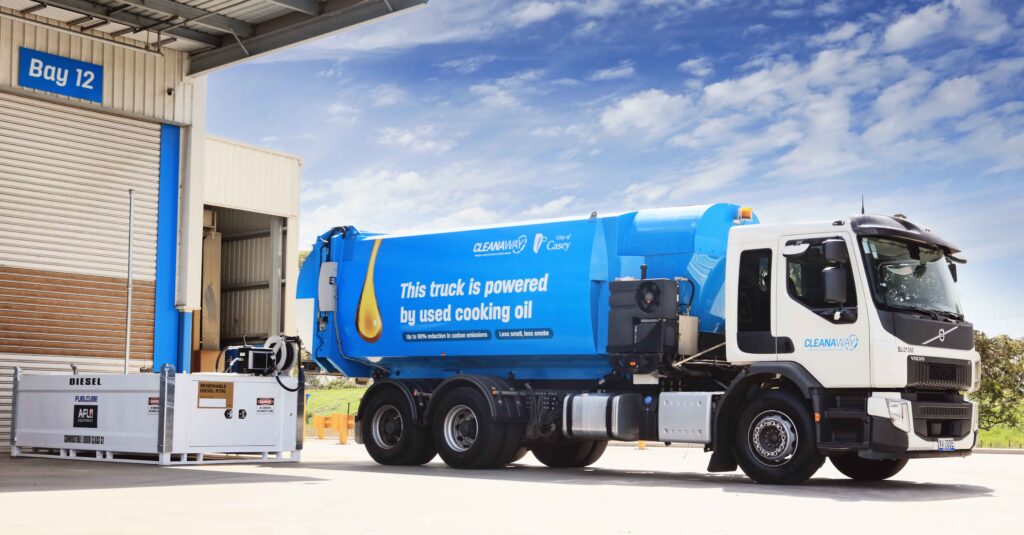
Pictured: Cleanaway vehicle next to HVO100 renewable diesel tank at Perry Road depot. Livery reads “This truck is powered by used cooking oil”.
Fuel consumption and emissions
Fuel consumption of both vehicles is summarised in the table below. For the frontlift organics truck we have observed a very similar performance between diesel and HVO100. In the sidelift truck, which has on average a much higher fuel consumption due to more frequent stopping, we have observed a lower consumption using HVO100.
The fuel consumption figures were confirmed by feedback from the drivers. For the frontlift organics truck, the driver did not notice any difference in refuelling frequency or power delivery. However, the sidelift truck driver noticed that the intervals between his refuelling had increased since the HVO100 demonstration began, indicating that he achieved more mileage from a full tank. This observation confirmed the fuel consumption data.
It is not yet clear what causes this lower consumption and why it is only observed in the sidelift vehicle. Cleanaway will monitor how this evolves throughout the demonstration.
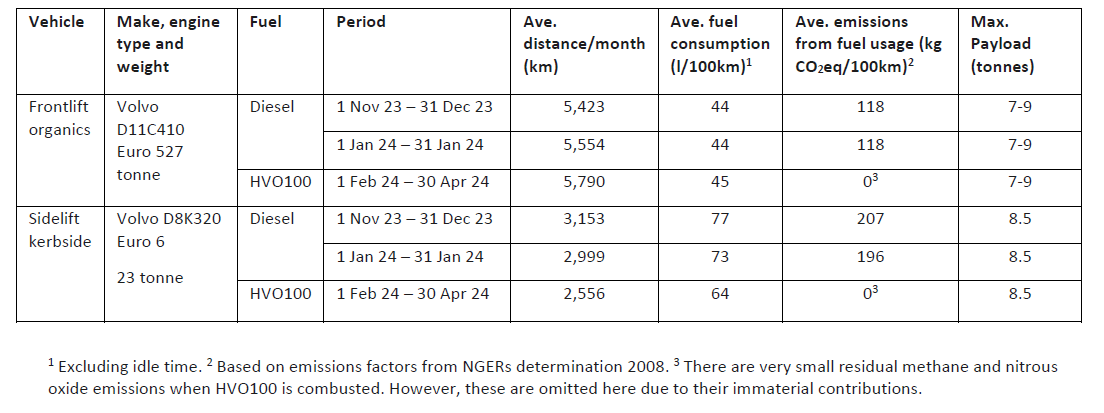
Exhaust gases were analysed using a gas analyser to measure CO and CO2 concentrations from the exhaust pipe. Measurements on the sidelift truck showed equivalent results between HVO100 and diesel when idle and at 1,500 rpm. HVO100 is approved as a reportable emissions reduction solution by the National Greenhouse and Energy Reporting Scheme (NGERS) and has negligible emissions from combustion as it is derived from renewable raw materials that have sequestered CO2 from the atmosphere when the biomass was grown. Based on the consumption figures in the table, the HVO100 demonstration has avoided a total of 37 t CO2 in the first three months of the demonstration across both trucks.
From a maintenance perspective, a fuel filter was extracted three months into the demonstration and it was noticeably cleaner compared to used filters from trucks running on mineral diesel.
Customer experience
Uptime and performance is essential for servicing Cleanaway’s customers.
Coles is one of two Cleanaway customers participating in the demonstration. “Our involvement in the trial of a Cleanaway truck powered by renewable fuel has been successful, with HVO100 currently completing 189 services per week across 72 of our stores in southeast Melbourne”, said Coles General Manager Sustainability, Brooke Donnelly. “This is an exciting opportunity to drive change in the industry and help to create a more sustainable future.”
Similarly, Cleanaway’s municipal customer, City of Casey, commented: “The City of Casey is proud to be part of Cleanaway’s HVO100 demonstration – using a lower carbon, diesel alternative to power one of Casey’s kerbside collection vehicles. We encourage our community to keep an eye out for the bright blue trucks operating on renewable fuel, attributed exclusively to used cooking oil. This emission reduction initiative is another step in the right direction in Council’s commitment towards zero net corporate emissions by 2030 in line with our Climate Action Plan.”
Operations
The local team supporting the demonstration has embraced this innovative approach to reducing carbon emissions – especially once they saw how well the vehicles performed. Cleanaway’s demonstration requires a dedicated refuelling system which is a change to process for the drivers. This approach also required a bespoke supply chain solution, which was supported by Cleanaway’s fuelling partner, Viva Energy, and increased the cost per litre.
Cost of HVO100 is a real challenge for scaling the program as renewable diesel is not currently attracting the same subsidies as other fuel types.
Government
Cleanaway is regularly engaging with the Fuel Quality team in the Australian Government Department of Climate Change, Energy, the Environment and Water on the trial. They are currently developing a paraffinic diesel standard to enable easier supply of renewable diesel in Australia. Cleanaway’s data on the performance of HVO100 in on-road trucks will support industry confidence in using the renewable diesel standard for Australia.
Cleanaway welcomes the support measures to drive the uptake of low carbon liquid fuels in Australia as part of the 2024-2025 budget, announced by the federal government.
- Investing $1.7 billion over the next decade in the Future Made in Australia Innovation Fund, to support the Australian Renewable Energy Agency to commercialise net zero innovations including low carbon liquid fuels.
- $18.5 million over four years from 2024-25 to develop a certification scheme for low carbon liquid fuels, including Sustainable Aviation Fuels and renewable diesel, in the transport sector by expanding the Guarantee of Origin scheme.
- $1.5 million over two years from 2024-25 to undertake a regulatory impact analysis of the costs and benefits of introducing mandates or other demand-side measures for low carbon liquid fuels.
- The Government will be undertaking targeted consultation to identify options for production incentives to support the establishment of a made in Australia low carbon liquid fuel industry.
Conclusion
Cleanaway is committed to incremental decarbonisation across our fleet and we hope to lead the way for heavy vehicles across Australia by investing in new and emerging technologies. Cleanaway has purchased two green hydrogen trucks, anticipated to come online later in 2024 and we have a limited number of electric vehicles in our fleet. HVO100 is an opportunity to reduce emissions from the current fleet of 3500 operating on traditional diesel which have a 10-year lifespan.
Cleanaway’s demonstration is providing important data and real-world experience for the development of a low carbon liquid fuels industry in Australia. Bioenergy Australia CEO Shahana McKenzie said: “This demonstration has been essential in moving the dial on low carbon liquid fuels with government, industry and businesses in Australia. Cleanaway is providing credible evidence to support policy, funding and build confidence for Australian businesses as they consider their decarbonisation pathways. We are confident that this demonstration has had a positive impact on the Federal Governments recognition of low carbon fuels in the 2024/2025 budget and Transport and Infrastructure Net Zero Consultation Roadmap”.
For more information about the demonstration, FAQs and sales material, please visit: Renewable Fuel | Cleanaway
Cleanaway renewable diesel demonstration drives down GHG from heavy vehicles
Cleanaway celebrates five years of serving Brisbane through Resource Recovery Innovation Alliance (RRIA)
“At the heart of this complex operation are the people, approximately 100 individuals from the RRIA administration team, resource recovery operators, drivers and the Brisbane Landfill team. These individuals are providing a truly essential service that keeps our city clean, green and healthy.”
“I truly believe the next five years are going to be really exciting and the work rewarding. We’ll be augmenting the systems we have in place to further remove garden organics and food organics while continuing to work on reducing resource losses.”
“At the heart of this complex operation are the people, approximately 100 individuals from the RRIA administration team, resource recovery operators, drivers and the Brisbane Landfill team. These individuals are providing a truly essential service that keeps our city clean, green and healthy.”
“I truly believe the next five years are going to be really exciting and the work rewarding. We’ll be augmenting the systems we have in place to further remove garden organics and food organics while continuing to work on reducing resource losses.”
Cleanaway and Brisbane City Council (BCC) officially launched the Resource Recovery Innovation Alliance (RRIA) in 2018. The alliance is a ten-year partnership for the management of Brisbane’s waste.
Under the alliance Cleanaway provides BCC with post collection and haulage services, operating five facilities – Brisbane Landfill (Rochedale) and four resource recovery centres (Chandler, Ferny Grove, Nudgee and Willawong).
During the 2022 floods this was expanded to 10 facilities in total. This included three temporary resource recovery centres set up specially for ‘Operation Collect’ which cleared 100,000 tonnes of waste during the crisis.
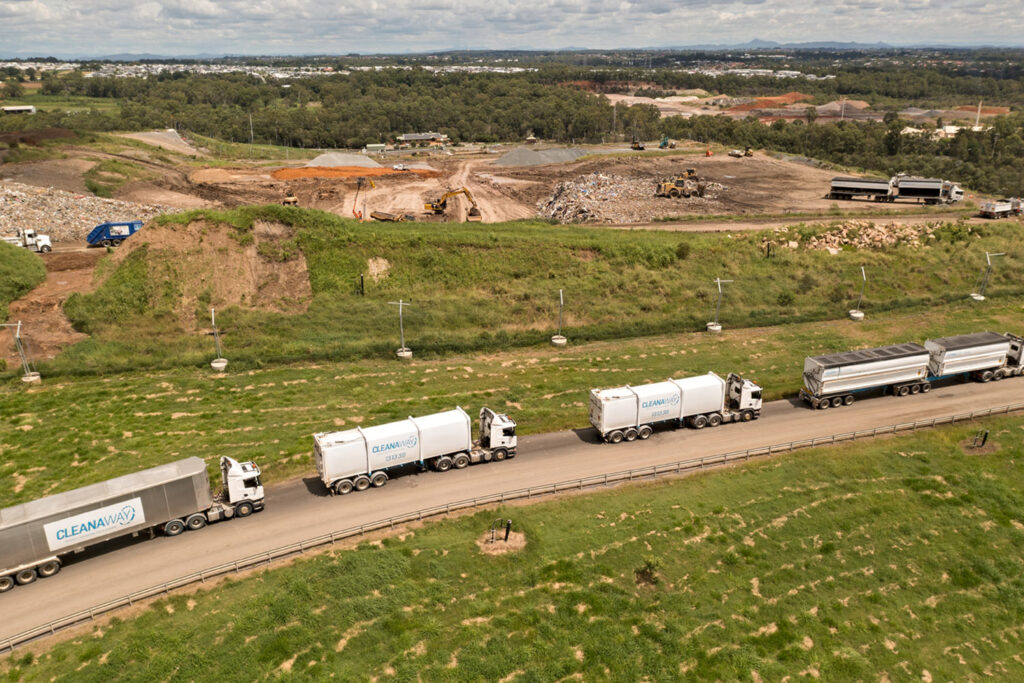
Pictured: Cleanaway trucks delivering flood waste gathered from Operation Collect to Brisbane Landfill.
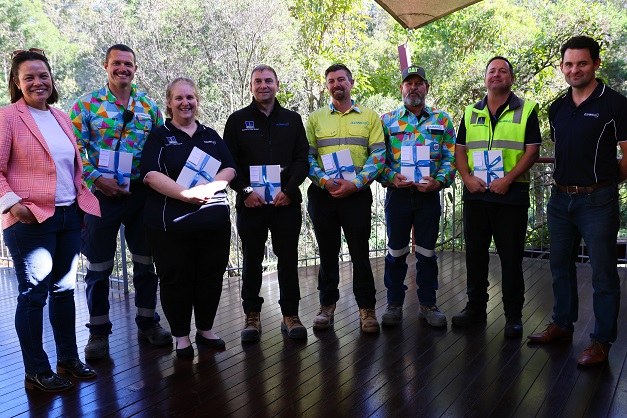
Pictured: Cleanaway Executive General Manager, Solid Waste Services Tracey Boyes (far left) with the Brisbane Landfill team. From left to right: Operator Duane Campbell, Admin Supervisor Kim Riddles, Supervisor Ewan Brooks, Branch Manager Joel McCumstie, Leading Hand Paul Adams, Supervisor Shaun Gilshenan and Queensland General Manager, Solid Waste Services Aaron Carter.
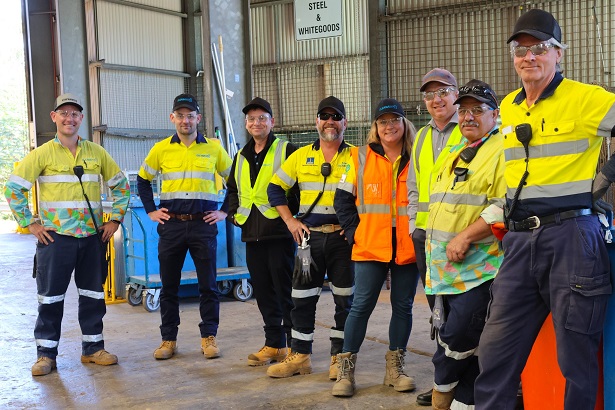
Pictured: The Chandler Resource Recovery Centre team (from left to right): Operator Rob Gorman, Queensland General Manager, Solid Waste Services Aaron Carter, Supervisor Ewan Brooks, Operator Adam Watt, Health & Safety Business Partner Emily Sime, Queensland Fleet Equipment Manager Matt Baxter, Operator Cliff McRoberts and Resource Recovery new starter Michael Howe.
2023 marks the fifth anniversary of the RRIA. To date the alliance has served the Brisbane community by:
- serving over 5.8 million customers
- transporting over 2.5 million tonnes of general waste
- diverting over 500,000 tonnes of waste from landfill via resource recovery operations.
RRIA Operations Manager Shannon Gorman said, “At the heart of this complex operation are the people, approximately 100 individuals from the RRIA administration team, resource recovery operators, drivers and the Brisbane Landfill team. These individuals are providing a truly essential service that keeps our city clean, green and healthy.”
“I truly believe the next five years are going to be really exciting and the work rewarding. We’ll be augmenting the systems we have in place to further remove garden organics and food organics while continuing to work on reducing resource losses.”
“This is on top of constantly looking for new and emerging markets for recoverable materials.”
Contact us to learn more about how we’re making a sustainable future possible for communities and businesses across Australia.
Cleanaway responds to herbicide spill via 1800 SPILLS emergency hotline
At 10.30pm on 30 January 2023 a call came in through our 24 hour emergency hotline 1800 SPILLS notifying Industrial Waste Services Wodonga (IWS Wodonga) of a chemical spill.
The IWS Wodonga team was informed that a freight truck carrying approximately 10,000 litres of glyphosate rolled at a roundabout in Ettamogah north of Albury.
There was no time to waste as the accident had forced a road closure.
IWS Wodonga liaised through the night with Albury Fire Brigade and put a plan in place to have the waste picked up and disposed of quickly and safely so that the road could be reopened to the public.
The team then reached out to Branch Manager Dave Collins from Solid Waste Services Albury-Wodonga (SWS Albury) who aided in getting the damaged intermediate bulk containers (IBCs) picked up.
Dave and his team also worked to supply the fire brigade with extra IBCs to complete the liquid transfer.
The type of waste and where it could be safely accepted complicated the task of containing the spill.
EBP Hayden Rossback communicated with the NSW Environment Protection Authority (NSW EPA) and arranged for temporary approval to store the product at Cleanaway’s Knights Road facility in Albury.
Branch Manager Daniel Saliba and Chemist Wayne Ling from Cleanaway’s Haztech team in Glendenning arranged for the pick up of the waste and damaged containers.
All in all, three separate Cleanaway divisions (IWS Wodonga, SWS Albury and Haztech Glendenning) collaborated to deliver a safe outcome for the public.
Our 24 hour emergency response hotline 1800 SPILLS (1800 774 557) is the number to have on hand for any organisation dealing with the transport or storage of waste, liquid products, chemicals and operational plants.
Our expert teams provide urgent containment and clean up for:
- grease trap and oily water
- stormwater or sewer/septic waste
- hazardous and non-hazardous spills
- factory or facility response
- bulk hazardous waste
- large chemical spills.
Contact us to learn more about how we’re making a sustainable future possible for communities and businesses across Australia.
FOGO no-nos for your bin
Not all kerbside FOGO bins can accept the same kinds of food and kitchen waste. This difference is due to the availability of the facilities nearby.
Not all kerbside FOGO bins can accept the same kinds of food and kitchen waste. This difference is due to the availability of the facilities nearby.
When it comes to kerbside organics recycling, what can go into your bin can differ wildly from council to council, not to mention state to state. Not all Food Organics and Garden Organics (FOGO) materials can go into your bin. Here’s what you should know about your kerbside FOGO bin:
Almost all FOGO bins will always accept grass clippings, small branches, and flowers in the kerbside organics bin. These can be placed as is in your bin, no bagging required. Be careful not to overfill your bin and that the lid can always be closed.
Not all FOGO are created equal
Not all kerbside FOGO bins can accept the same kinds of food and kitchen waste. This difference is due to the availability of the facilities nearby. Not all facilities are able to process food and kitchen waste, especially cooked food and bones.
What you can do
If you have access to a FOGO bin, always check with your council before placing food waste into the bin. If you cannot place food in your kerbside organics bin, look around in neighbourhood chats to find composting groups for your food waste.
Meal planning and making a list of groceries you need will also help you cut down on potential food waste. Across the supply to consumption chain, it is estimated that Australians waste around 7.6 million tonnes of food annually, the equal of 312kg per person. Planning both your meals and your grocery will help cut down on this.
Contact us to learn more about making a sustainable future together possible with your organics waste.
Sustainability projects for the new school term
“Swap sandwich bags and cling wrap for reusable containers, beeswax wraps or silicone sandwich bags that can be washed and re-used.”
“Swap sandwich bags and cling wrap for reusable containers, beeswax wraps or silicone sandwich bags that can be washed and re-used.”

The new school term is a great opportunity to start the sustainability conversation with young students. Here are some simple and practical projects you can explore:
Improving lunchboxes
Cleanaway Education Officer Michelle Murrell recently shared some simple changes to make school lunchboxes sustainable.
“Swap sandwich bags and cling wrap for reusable containers, beeswax wraps or silicone sandwich bags that can be washed and re-used,” she suggests, pointing out that otherwise, using single-use plastic sandwich bags can send around 180 bags sent to landfill per child, per year.
The same goes for disposable water bottles, which requires 3 litres of water and 250ml of oil to produce a single water bottle containing 1 litre of water.
Food waste is especially concerning, as large amounts are being thrown away – wasting not just the resources to grow and produce the food, but also the money on purchasing it in the first place. Michelle suggests involving children in the process of making recess and lunch and letting them choose what to eat. This hands-on approach can “encourage them to spend the time eating the food and not throwing it away.”
Finally, she also points out that if food is coming home, stop sending any to school. Children will let you know if they need more food. As play time often follows eating time, children may decide to forfeit food for more play time, so consider packing food that’s quick and easy to eat.
What goes into the bin
The Australasian Recycling Label, introduced in 2018 to provide recycling information, can help spark conversations and discussions about packaging and help ensure the right materials go into the bin. Planet Ark has a comprehensive Educator’s Tool Kit to help educators and schools introduce this topic to students.
A waste audit is also an effective way to get students to think about what goes in a bin. It’s a practical approach that gets students thinking creatively about waste and its effect on the environment.
From trash to treasure
Creating meaningful artwork from discarded waste can also help students appreciate both their natural environment and kindle a love for sustainability. Activities such as Gympie’s recent “Junk for Junk” and Cleanaway’s Waste Warrior Challenges encourage creativity and heightened sensitivity to the effects of waste on the environment.
It sounds unusual, but worm farming is a novel way to teach students about sustainability while helping schools manage their organic waste, particularly food. Worm farms and compost heaps can get students thinking about where their food comes from and the effort it takes to grow them.
Contact us to learn more about making a sustainable future possible together for your students and school today.